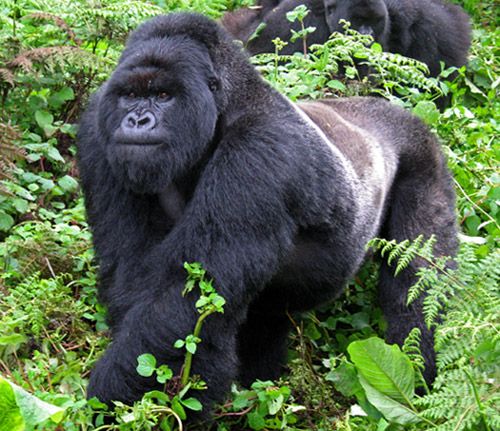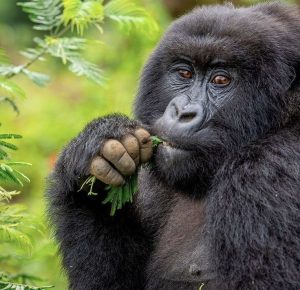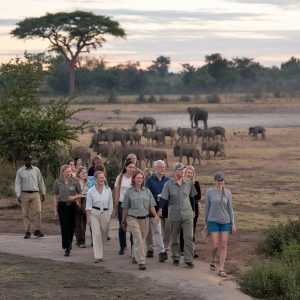Where is Volcanoes National Park located, and why is it famous for gorilla trekking?
Volcanoes National Park sits in the northwestern region of Rwanda, bordering Uganda and the Democratic Republic of Congo. It spans approximately 160 square kilometers of lush volcanic mountains and dense forests. This park has earned global recognition for offering one of the most iconic wildlife experiences: gorilla trekking. Its reputation stems from both its natural beauty and its historic role in great ape conservation. Volcanoes National Park Gorilla Trekking Compared to other parks
Volcanoes National Park is famously linked to the pioneering work of Dian Fossey, a renowned primatologist who dedicated her life to studying and protecting mountain gorillas here. The park’s extensive efforts in habituating gorilla families for responsible tourism have made it a leader in ethical wildlife encounters. Tourists come from all corners of the world to trek through mist-covered mountains and observe gorilla families in their natural habitat, experiencing firsthand the behavior and social dynamics of these magnificent primates. Volcanoes National Park Gorilla Trekking Compared to other parks
How does the accessibility of Volcanoes National Park compare to other gorilla trekking parks?
Volcanoes National Park is one of the most accessible gorilla trekking destinations in Africa, especially for international travelers. The park lies just about a 2.5 to 3-hour drive from Kigali International Airport, Rwanda’s main gateway. This close proximity allows visitors to reach the trekking starting points with ease, even for short itineraries or same-day tours from Kigali.
In comparison, Uganda’s Bwindi Impenetrable Forest is more remote, requiring a full day’s drive from Entebbe International Airport or a domestic flight plus lengthy road transfer. Bwindi’s rugged terrain and less developed road infrastructure extend travel times significantly.
Meanwhile, Virunga National Park in the Democratic Republic of Congo, although geographically close to Volcanoes, has more complex access logistics. Travel involves border crossings, security checks, and occasionally volatile security conditions, which can complicate visits despite the park’s incredible gorilla populations.
What are the differences in trekking terrain and difficulty among Volcanoes, Bwindi, and Virunga?
Volcanoes National Park offers a mix of mountainous terrain and dense forest trails. The trekking routes typically include steep ascents and descents across volcanic slopes and ridges but benefit from well-maintained paths due to decades of tourism development. The trails are moderately challenging and suitable for most physically fit travelers.
Bwindi Impenetrable Forest, by contrast, is renowned for its extremely dense and rugged terrain. The forest earned its “impenetrable” nickname due to thick undergrowth, tangled vines, and steep hillsides. Trekkers often face physically demanding hikes through mud, slippery roots, and sharp inclines. This makes Bwindi a more strenuous experience requiring good stamina.
Virunga National Park’s trekking terrain varies. Some gorilla families inhabit volcanic bamboo forests that are relatively open, while others dwell on steep volcanic slopes. Trekking conditions in Virunga depend on the exact location of the gorillas on the day, but visitors should be prepared for potentially challenging hikes through rough, remote terrain.
How many habituated gorilla families does Volcanoes National Park have compared to other parks?
Volcanoes National Park hosts approximately 12 habituated mountain gorilla families available for trekking. These groups have been carefully habituated over decades, allowing for close but non-intrusive human observation. This habituation process helps protect the gorillas while supporting responsible tourism.
Bwindi Impenetrable Forest has more habituated groups—over 20 families across several sectors—making it the park with the highest number of habituated gorillas. This greater number means trekkers have more flexibility when selecting permits but also more dispersed trekking locations.
Virunga National Park has fewer habituated gorilla families, generally fewer than 10, but this is slowly increasing thanks to ongoing conservation efforts. The smaller number of groups means fewer tourists at any given time, which some travelers prefer for a more exclusive experience.
How do gorilla trekking permit costs compare between Volcanoes, Bwindi, and Virunga?
Permit costs are a significant factor for travelers planning gorilla trekking. Rwanda’s Volcanoes National Park charges USD 1,500 per permit for foreign non-residents, the highest fee in the region. This fee supports conservation, park management, and community development projects. The premium price also reflects Rwanda’s world-class infrastructure, guiding expertise, and reliable gorilla sighting success rates.
In Uganda, Bwindi permits cost USD 800 per person, making it a more affordable option while still delivering a high-quality trekking experience. The lower permit price has made Bwindi a popular choice for budget-conscious travelers and groups.
The Democratic Republic of Congo’s Virunga National Park offers permits at approximately USD 400, which is the lowest price among the three. However, potential visitors must weigh this against added travel complexity and security considerations.
What tourism infrastructure and safety measures make Volcanoes National Park stand out?
Volcanoes National Park benefits from Rwanda’s robust tourism infrastructure. The country has invested heavily in well-trained park rangers, professional guides, and visitor facilities. The park’s management prioritizes visitor safety and gorilla welfare, enforcing strict rules during trekking, including limited group sizes, enforced distances, and health screening to minimize disease transmission.
Rwanda also maintains political stability and excellent road networks leading to the park. The park supports community initiatives that involve local people in tourism benefits, fostering goodwill and enhancing conservation success.
Bwindi, while offering a highly rewarding experience, tends to have more rustic facilities and longer travel times, though community involvement remains strong. Virunga, while breathtaking, operates in a region with occasional security challenges, and visitor infrastructure is less developed, requiring careful planning.
How reliable are gorilla sightings in Volcanoes compared to Bwindi and Virunga?
Gorilla sighting success rates in Volcanoes National Park are consistently high, exceeding 95%. The habituated families are well monitored daily by trackers, allowing guides to locate them quickly for visitors. This reliability, combined with small trekking groups, ensures a high-quality, intimate wildlife encounter.
Bwindi also boasts high gorilla sighting success, often above 90%, though the larger forest area and variable terrain can sometimes make trekking longer or more unpredictable.
Virunga’s sightings are less predictable due to fewer habituated groups and occasional security-related disruptions. However, when sightings occur, the experience can be highly rewarding due to the park’s wild and pristine setting.
What other wildlife and attractions can visitors enjoy at Volcanoes, Bwindi, and Virunga?
Volcanoes National Park offers more than gorilla trekking. Visitors can track golden monkeys, hike scenic trails like the Dian Fossey Memorial Trail, and explore the Virunga volcanic range’s breathtaking landscapes. Nearby cultural experiences include visits to local communities and genocide memorials in Musanze.
Bwindi’s biodiversity extends beyond gorillas. The forest shelters over 350 bird species, several primates like chimpanzees and colobus monkeys, and endemic plants. Bwindi is also a hotspot for birdwatchers and nature enthusiasts.
Virunga National Park features active volcanoes, hot springs, and a wide variety of mammals including elephants, lions, and hippos. It is East Africa’s oldest national park and offers exceptional hiking and safari opportunities alongside gorilla trekking.
When is the best time of year to go gorilla trekking in Volcanoes and other parks?
The best time for gorilla trekking in Volcanoes National Park and surrounding regions is during the dry seasons: from June to September and December to February. During these months, trails are less muddy and wildlife tends to be more active and visible. These dry periods offer safer and more comfortable trekking conditions.
While the rainy seasons (March to May and October to November) bring lush greenery and fewer tourists, they also make trekking more difficult due to slippery and muddy trails. Many travelers prefer the dry season for both Volcanoes and Bwindi, but some enjoy the forest’s vibrant atmosphere during rains.
Virunga’s trekking seasons largely align with these periods, but visitors must also monitor regional security updates before planning their visit.
How do I book gorilla trekking permits for Volcanoes National Park and the other parks?
For Volcanoes National Park, gorilla trekking permits must be booked through the Rwanda Development Board (RDB) or via reputable tour operators. Due to high demand and limited permits (usually only 8 people per gorilla group per day), advance booking several months ahead is essential, especially during peak seasons.
Uganda’s Bwindi permits are managed by the Uganda Wildlife Authority (UWA) and can be booked online or through licensed agents. Early booking is also advised here due to increasing tourism demand.
Virunga permits are coordinated through the Institut Congolais pour la Conservation de la Nature (ICCN). Travelers should use established tour companies with experience in the region to ensure safe and valid permits.
Which gorilla trekking park offers the best overall experience for visitors?
The answer depends on your priorities. If convenience, guaranteed sightings, excellent facilities, and strong conservation impact top your list, Volcanoes National Park is the best choice. Rwanda’s well-organized tourism infrastructure ensures a smooth, memorable, and safe trek.
If you seek a more rugged, immersive forest experience with a lower permit cost, Bwindi Impenetrable Forest offers exceptional wildlife encounters but requires more travel time and physical effort.
For adventurous travelers looking for a remote, less crowded destination, and who are comfortable navigating more complex logistics, Virunga National Park provides a unique and wild gorilla trekking experience.
Conclusion Volcanoes National Park Gorilla Trekking Compared to other parks
Gorilla trekking in Volcanoes National Park stands out as a premier wildlife adventure due to its accessibility, high habituation standards, safety, and tourism quality. While Bwindi and Virunga each offer distinct advantages, Volcanoes’ blend of convenience and conservation success sets a global benchmark. Choosing the right park ultimately depends on individual preferences, budget, and travel style—but all three destinations promise life-changing encounters with one of Earth’s most majestic species. Volcanoes National Park Gorilla Trekking Compared to other parks




